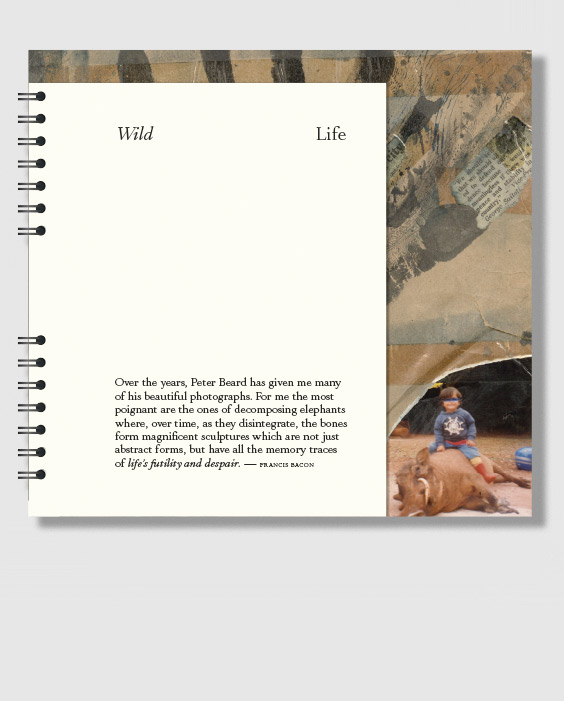
Wild Life: Francis Bacon and Peter Beard
Ordovas Books, 2021
Designed by Sinead Madden, London.
ISBN 978-1-9996681-7-4
10 5/8 x 11 3/8 inches (27 x 29 cm); 96 pages; fully illustrated in color
Wild Life: Francis Bacon and Peter Beard explores the friendship between Francis Bacon (1909–1992) and Peter Beard, his long-time friend and muse. Despite working on different sides of the world, the two artists shared deeply similar personal and creative passions. Intended as a celebration of Beard’s life, the exhibition features works from the period of the two artists’ friendship shown side by side for the first time, along with unseen materials from Beard’s archives including letters and photographs gifted to Bacon and, most importantly, Beard’s diaries, which served as the genesis for his art. The accompanying catalogue includes essays by Martin Harrison and Sophie Pretorius.
Purchase information:
https://www.ordovasbooks.com/product/wild-life/.
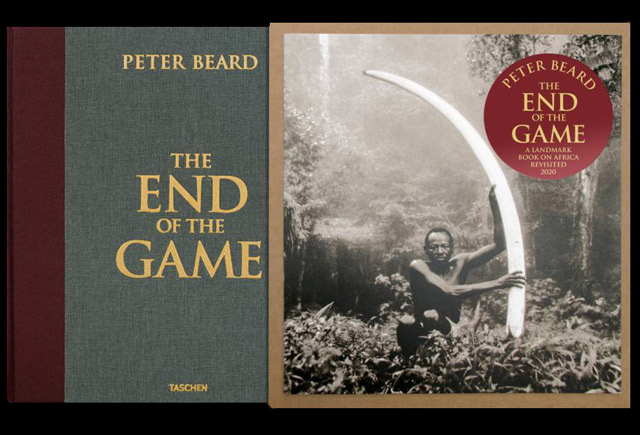
Beard, Peter. The End of the Game.
Germany: Taschen, 2020
ISBN 978-3-8365-8486-9.
This new edition includes an interview with conservationist Dr. Esmond Bradley Martin and Peter Beard, first published in Africana magazine, in March 1979. It addresses the furor that the 1977 edition of The End of the Game caused with the last chapter titled, “Nor Dread Nor Hope Attend” which features a wordless montage of dead elephants and dead landscapes in Tsavo. Peter Beard states, “The decline of habitat is what the book is about; the decline in animal numbers was what followed. In a sense, ‘The End of the Game‘ as a title means the end of a period of time when we could play games and fool around with the wild beasts in the wilderness. Now there’s no time for this, and less and less space. We’ve ended up in a claustrophobic, artificial, zoo-like, concrete corner.”
Essays are also included from previous editions by renowned writer Paul Theroux and ecologist Dr. Richard M. Laws, and contributions to the afterword by agronomist Dr. Norman Borlaug. Touching on such themes as distance from nature, density and stress, and loss of common sense, this seminal portrait is as resonant today, amid growing environmental crises, as it was a half century ago.
“Beard’s introductory text to The End of the Game, with dexterity and wry humour, extracts from the rich primary source material of his own photos and diaries, and that of his predecessors, an astounding and personal history of the white man’s involvement in the hunting of big game in equatorial Africa. The reader should take note, however, that each new edition of The End of the Game published during Beard’s lifetime developed as his diaristic style developed. Each one retained more and more of the scrapbooked fragment than the last and each kept pace with the development of the truth of the animal situation in Kenya. Thus, each edition could almost be said to be a new artefact, and they cannot be substituted for each other. If Beard’s mission in the first edition was to illustrate the Africa being left behind by the velocity of change on the continent, a task he considered something of a homework assignment regarding his predecessors, the 1977 and 1988 editions venture further into the expression of terrifying truths. With the addition of the subtitle The Last Word from Paradise, their last chapters document the disastrous repercussions of the first, misguided wave of what Beard called ‘sentimental’ reactionary ecology or conservationism in the time since 1965. These later editions contain perhaps Beard’s most famous and poignant photographs, his aerial shots of dead elephants who had starved to death due to overpopulation caused by conservation efforts in Kenya’s Tsavo National Park (p. 31). These animals, being protected from ‘poachers’ trying to steal their ivory, had been herded into national parks too small to support their numbers. For sentimental and budgetary reasons, there had been no attempt at game control, ‘poaching’ had been outlawed and the elephants had been left to ‘find their own level.’ In so doing, these now severely overcrowded animals ate through the once thickly forested area, desertifying it. In Beard’s images they lie starved to death, with their precious ivory ironically still attached.”
-Sophie Pretorius, The Crime of the Century essay from Wild Life: Francis Bacon and Peter Beard, Ordovas Books, London, 2021
“The End of the Game is the only wildlife book I know that tells the truth. Contained in these pages of photographs – many of them shocking – taken over 20 years, is evidence that we must begin at once to reverse the complex origins of our apathy. Here we find ‘the elephants’ graveyard’ and a mandate to try and rearrange our own fate this side of the politics of sentimentality and anthropomorphism … this book should come to the attention of the dedicated preservation groups, as it brings out into the open a ‘wildlife Watergate’ for which they to a certain extent are responsible.”
-Dr. Norman E. Borlaug, Nobel Peace Laureate, 1970, Inventor and Developer of the Green Revolution
“The dead elephant carcasses are also perversely elegant in the extreme: a ballet of unrecognizable performers, Muybridge’s Animal Locomotion in full decay. Beard has in effect done for the elephant what the painter Francis Bacon did to the human body, but with the photographer’s edge of documentary truth.”
-Robert Hughes, Time, December 1977
Purchase information:
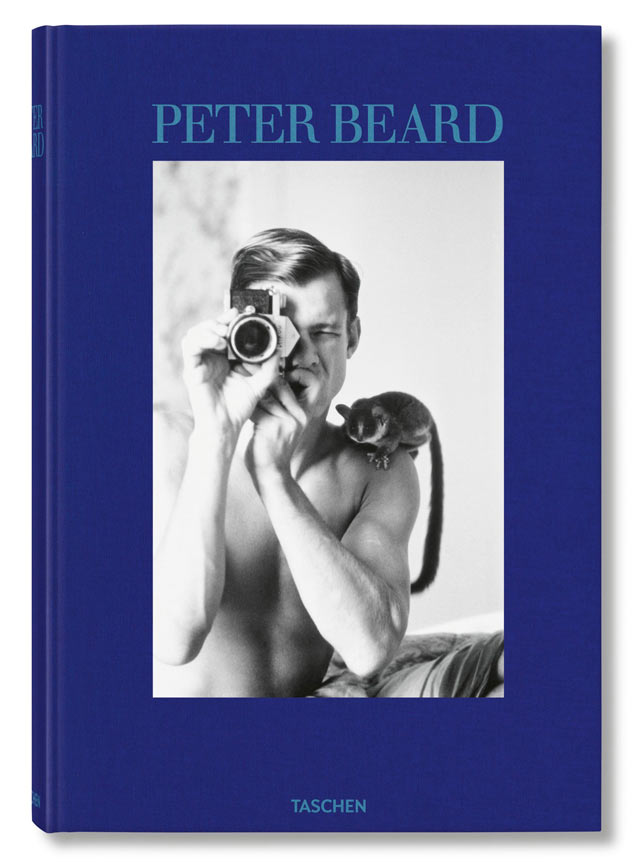
Taschen, Peter Beard
Multilingual edition published in English, French, and German, available in June 2020 with pre-orders accepted now.
In 2006, TASCHEN first published the book that has come to define his oeuvre, signed by the artist and published in two volumes. It sold out instantly and became a highly sought-after collector’s item. In the decade since, the monograph has been revived in three smaller versions: 2008, 2013, and now 2020.
Now available: a 4th edition in one volume.
Purchase the book here.
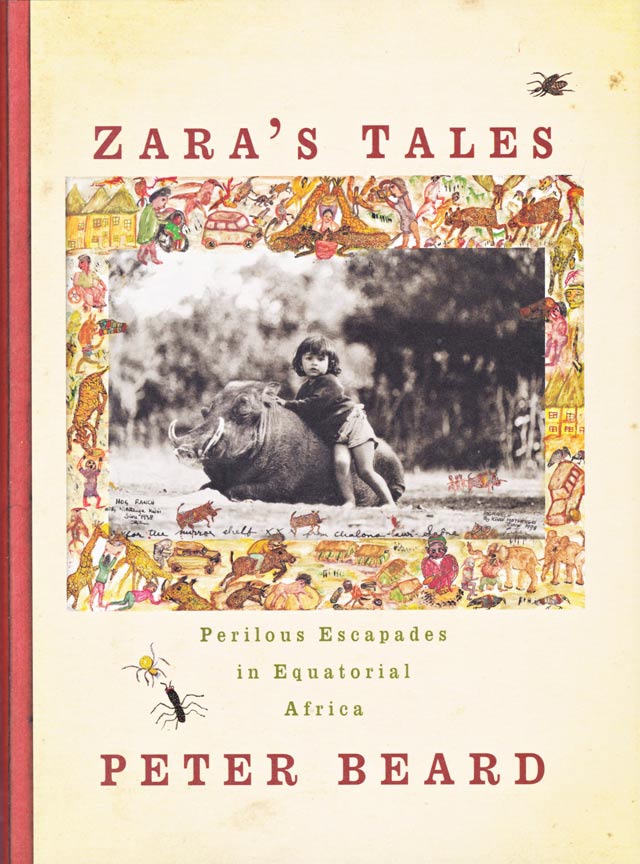
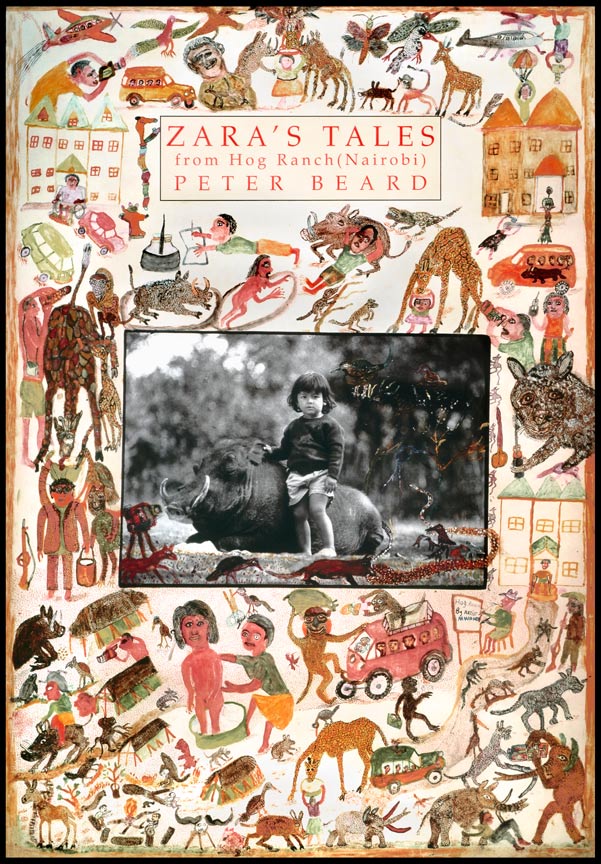
Zara’s Tales, book soon to be back in print. Available in June 2020 with pre-orders accepted now.
Zara’s Tales, poster, signed limited edition.
Purchase the book here.
To purchase the poster, please contact: jill@peterbeard.com
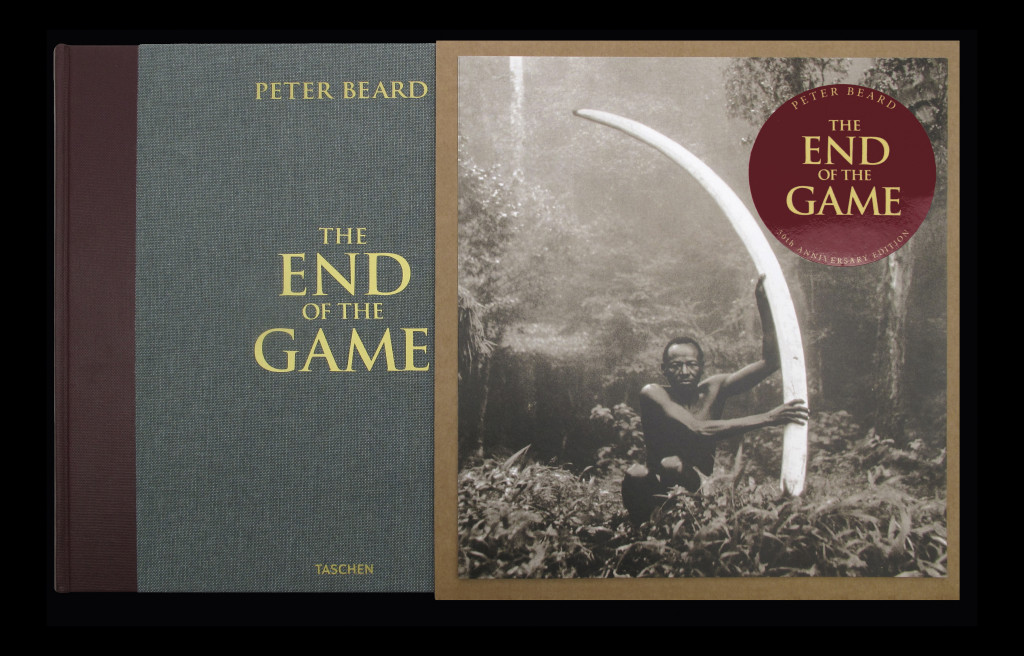
Beard, Peter. The End of the Game. 50th Anniversary Edition. Germany: Taschen, 2015. ISBN-978-3-8365-5547-0.
The End of the Game. 50th Anniversary Edition
“The deeper the white man went into Africa, the faster the life flowed out of it, off the plains and out of the bush … vanishing in acres of trophies and hides and carcasses.” – Peter Beard
A landmark publication on Africa, The End of the Game, combines Peter Beard’s salient text and remarkable photographs to document the overpopulation and starvation of tens of thousands of elephants, rhinos, and hippos in Kenya’s Tsavo lowlands and Uganda parklands in the 1960s and ’70s.
Researched and compiled over two decades, Beard offers a powerful and poignant testimony to the damage done by human intervention in Africa. His own images and texts are supplemented by the writings and historical photographs of the enterprisers, explorers, missionaries and big-game hunters whose quest for adventure and “progress” were to change the face of a continent: Theodore Roosevelt, Frederick Courteney Selous, Karen Blixen (Isak Dinesen), Philip Percival, J.A. Hunter, Ernest Hemingway and J.H. Patterson.
In this fiftieth anniversary edition, limited to 5,000 copies, TASCHEN republishes The End of the Game in rich duotone and with an updated foreword by internationally renowned travel and fiction writer Paul Theroux. Touching on such themes as distance from nature, density and stress, and loss of common sense, this seminal portrait is as resonant today, amid growing environmental crises, as it was a half century ago.
“Unforgettable … Prophetic … one of the classics of unambiguous warning about humans and animals occupying the same dramatic space.” – Paul Theroux
“Over the years, Peter Beard has given me many of his beautiful photographs. For me the most poignant are the ones of decomposing elephants where, over time, as they disintegrate, the bones form magnificent sculptures which are not just abstract forms, but have all the memory traces of life’s futility and despair.” – Francis Bacon
“Very few matters could move me as deeply as your epitaph, or monument, over that Old Africa which was so dear to my heart — the continent of wisdom, dignity, and deep poetry, equally expressed in nature, beast, and man.” –Karen Blixen
“I haven’t looked at The End of the Game in nearly 30 years, and I am bowled over by how perceptively current it still seems. Books written about the environment now all sound like they’re by Eeyore. This one is brilliant and amusing and enthusiastic, so keenly felt and observed, and still bizarrely individual. It has little sense of a western structure. It meanders like a journey or like a conversation around a campfire, memorializing great hunters but also mourning the lost game. It ends with a series of photographs of dead and desiccated elephants who have all starved to death in the Tsavo National Park. These images are the most powerful conclusion to any book made about environmental destruction. The illustrations in The End of the Game juxtapose images of antique photographs with tribal drawing, placing the prosaic next to the horrifying, nostalgia overlaying modernity.”
-A.A. Gill
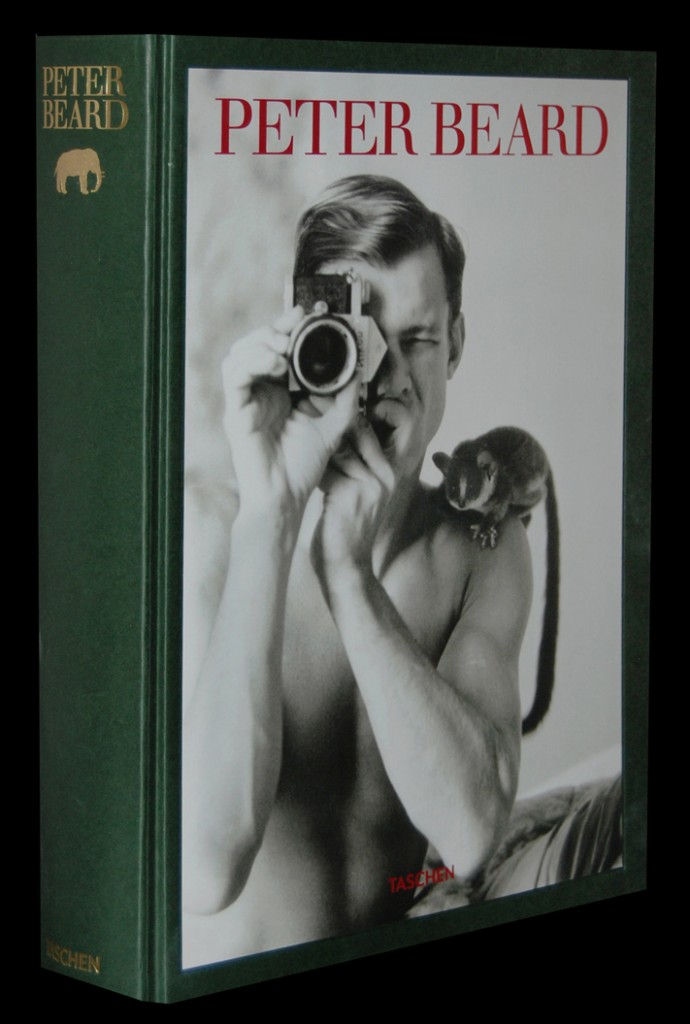 Beard, Peter; Beard, Nejma; Edwards, Owen; Aronson, Steven M.L. Peter Beard, Trade Edition. Germany: Taschen, 2013. ISBN-978-3-8365-3088-0
Beard, Peter; Beard, Nejma; Edwards, Owen; Aronson, Steven M.L. Peter Beard, Trade Edition. Germany: Taschen, 2013. ISBN-978-3-8365-3088-0
Peter Beard, Trade Edition
Artist, diarist, collector, and writer Peter Beard has fashioned his life into a work of art; the illustrated diaries he kept from a young age evolved into a serious career as an artist and earned him a central position in the international art world. He collaborated with Francis Bacon and Salvador Dali, he made diaries with Andy Warhol, worked on books with scientists like Dr. Norman Borlaug, Dr. Richard Laws, and Alistair Graham, and toured with Truman Capote, Terry Southern, and the Rolling Stones – all of whom are brought to life, literally and figuratively, in his work. He delved into the world of fashion for its beautiful women, taking Vogue stars like Veruschka to Africa and bringing new ones back to the U.S. with him.
After spending time in Kenya and striking up a friendship with the author Isak Dinesen (Karen Blixen) in the early 1960s, Beard bought 50 acres next to her farm with the stipulation that he would film and write about the land and its flora and fauna. He witnessed the dawn of Kenya’s population explosion, which challenged finite resources and stressed animal populations – including the starving elephants of Tsavo dying by the tens of thousands in a wasteland of eaten trees. So he documented what he saw – with diaries, photographs, and collages. He went against the wind in publishing unique and sometimes shocking books of these works, including The End of the Game. The corpses were laid bare; the facts carefully recorded, sometimes in type and often by hand. Beard uses his photographs as a canvas onto which he superimposes multi-layered contact sheets, ephemera, found objects, newspaper clippings that are elaborately embellished with meticulous handwriting, old-master inspired drawings, and often swaths of animal blood used as paint.
Purchase information:
http://www.taschen.com
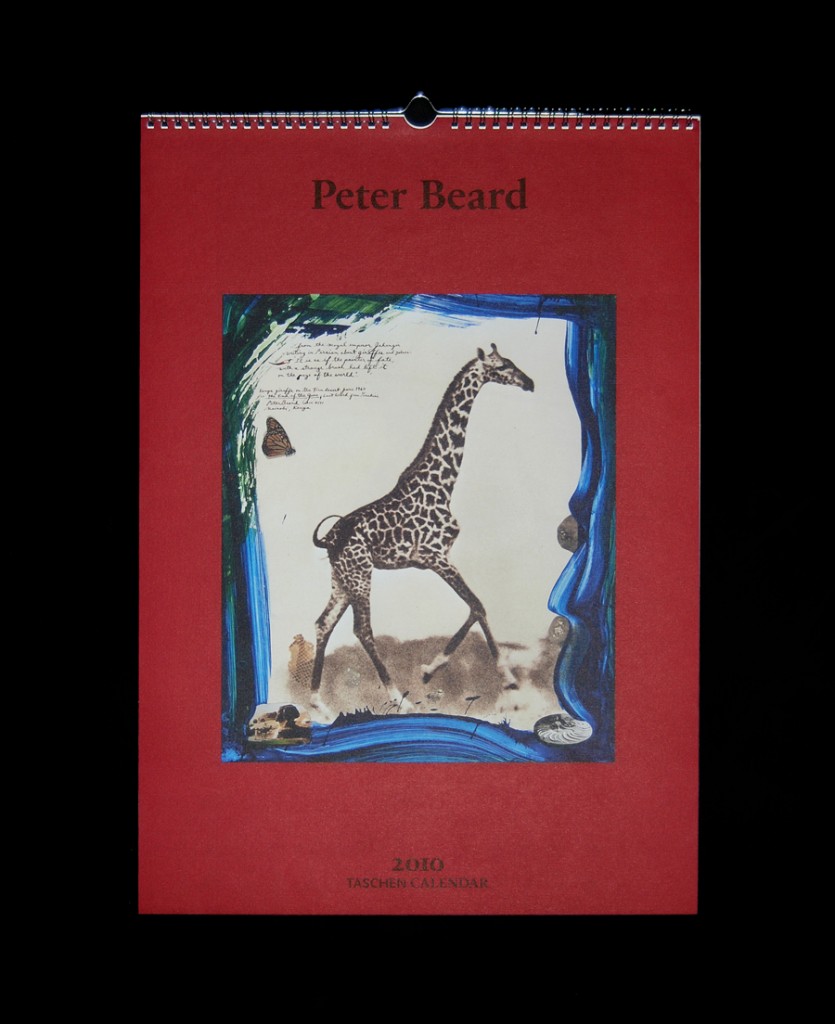 Peter Beard Wall Calendar
Peter Beard Wall Calendar
Published 2010
© 2009 TASCHEN GmbH All Beard works © Peter Beard. Used by permission. 13.4 x 19.3 inches (34 x 49 cm) 12 calendar pages, 12 illustrations ISBN 978-3-8365-1671-6
The 2010 Wall Calendar presents a distinctive collection of images of the artist’s work as seen in his diary pages, portraiture, and fashion photography.
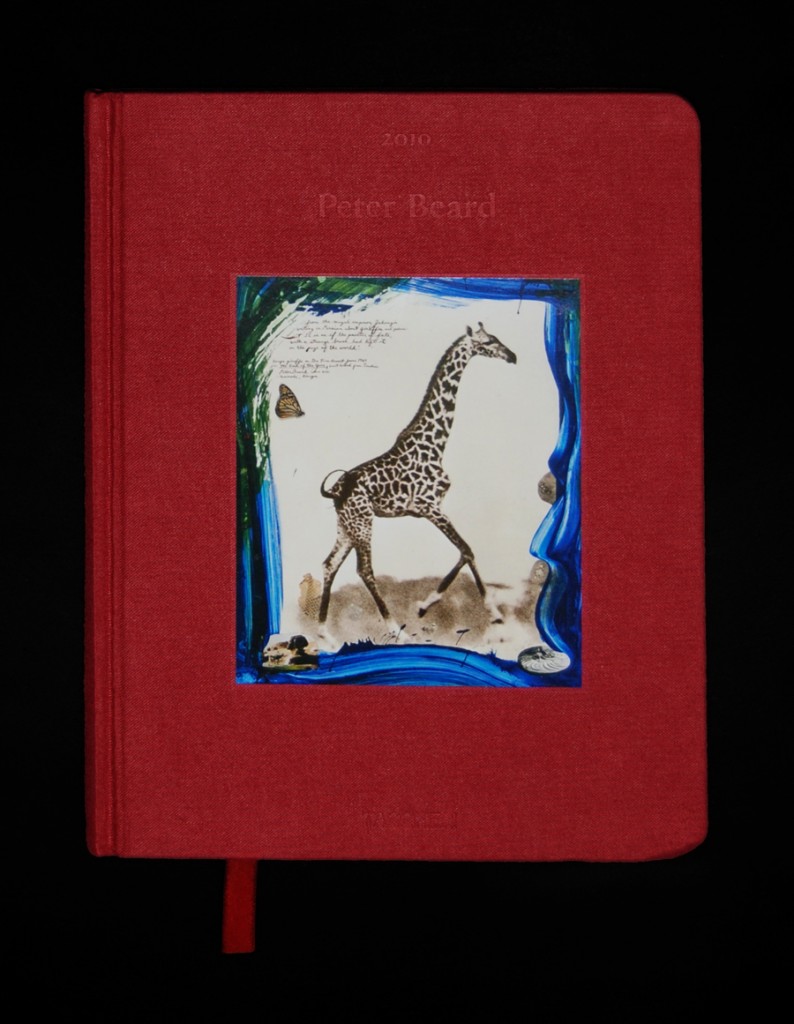 Peter Beard Deluxe Calendar (desk diary)
Peter Beard Deluxe Calendar (desk diary)
Published 2010
© 2009 TASCHEN GmbH All Beard works © Peter Beard. Used by permission 6.9 x 8.7 inches (17.4 x 22cm) 128 Pages, 58 illustrations ISBN 978-3-8365-1659-4
A personal collection of Peter Beard’s iconographic works from the intimacy of his own diary pages to his major constructs of striking images overlaid with historic collage, found objects, ink drawing, and salient writings. This diary presents a variety of images of his personal encounters with people, places, personalities through time and space —- created as only Beard can do.
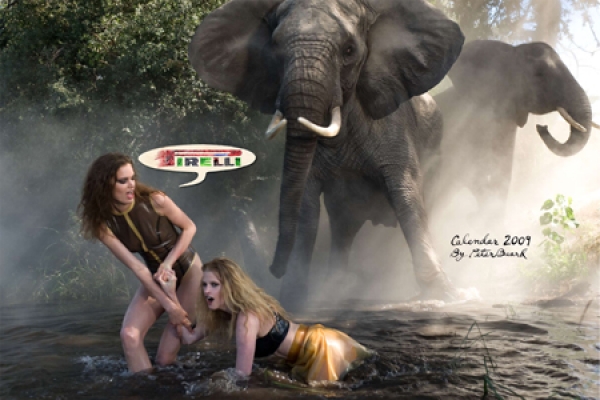 Pirelli Calendar
Pirelli Calendar
Published 2009
From Pirelli: “The calendar distribution is not in anyway linked to commercial strategies, therefore it is not on sale.”
The final result is a calendar/ diary that Peter Beard describes as “living sculpture”. The 56 plates of the new calendar are a rich collage of images, quotations, and observations by the artist on the environment, climate change and global warming, over population, human emissions and selfish depletion of natural resources. “My concern is the destruction of nature on a global scale. We are the enemies of nature, killing with kindness is our middle name. From Walt Disney to runaway sentimentality—especially at fundraising time – hug the babies. We’ve lost track of our position on space-ship earth. Even Darwin has been swept under the rug. Understanding basic biology, zoology, natural history and Diversity in nature spells the very foundation of our future survival and quality of life through intelligent management not always featuring human greed, irresponsible breeding and over all selfishness.”
The Secretary-General of the UN Convention on International Trade in Endangered Species of Wild Fauna and Flora (CITES), Mr. Willem Wijnstekers, congratulated Pirelli for dedicating its 2009 calendar to the theme of wildlife and our puncheon for domestic compromises, stress and density related illnesses (shared with elephant over-populations eating-up all the trees):
“We share Peter Beard’s desire to mobilize public opinion around respect for wildlife and appreciate the beautiful images Pirelli has featured. This is why we have asked the company to cooperate in developing other positive messages linked to CITES conservation initiatives. We expect that this highly aesthetic Calendar will appeal to other companies as well as philanthropic citizens to support our activities.”
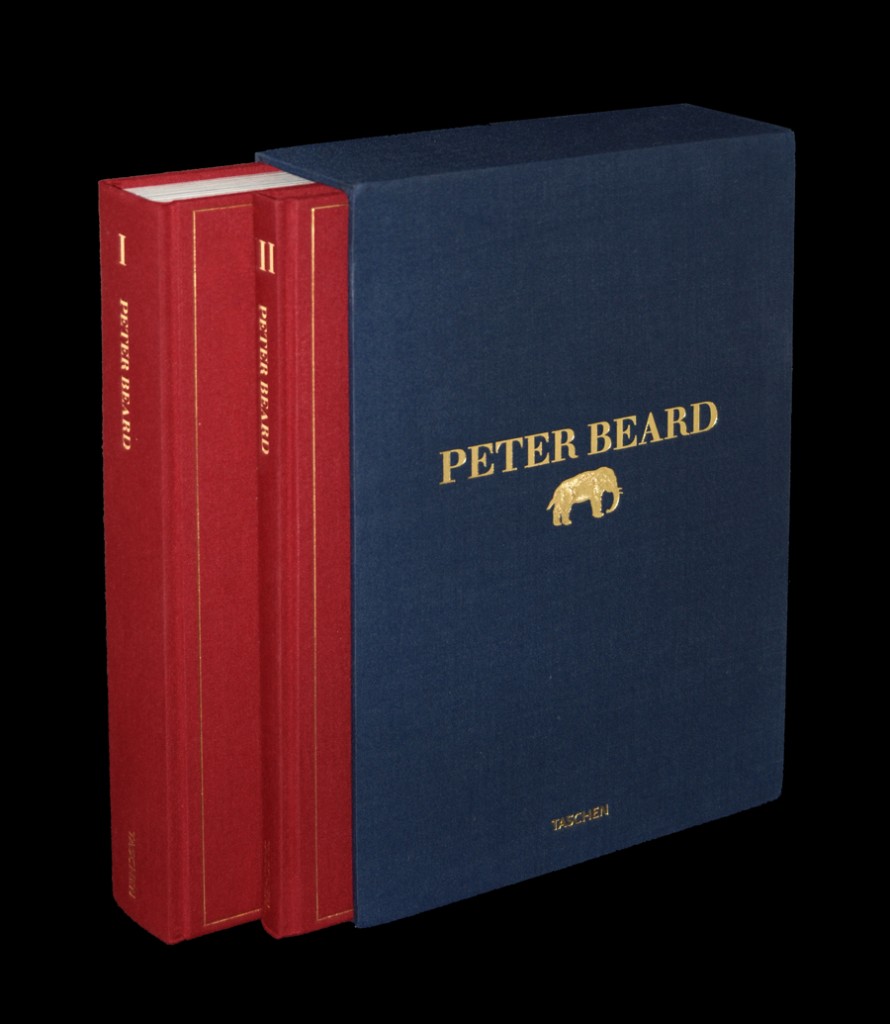 Beard, Peter; Beard, Nejma; Edwards, Owen; Aronson, Steven M.L. Peter Beard, Trade Edition. Germany: Taschen, 2008. ISBN-10: 383650877X. ISBN-13: 978-3836508773
Beard, Peter; Beard, Nejma; Edwards, Owen; Aronson, Steven M.L. Peter Beard, Trade Edition. Germany: Taschen, 2008. ISBN-10: 383650877X. ISBN-13: 978-3836508773
Peter Beard, Trade Edition
Artist, diarist, collector, and writer Peter Beard has fashioned his life into a work of art; the illustrated diaries he kept from a young age evolved into a serious career as an artist and earned him a central position in the international art world. He collaborated with Francis Bacon and Salvador Dali, he made diaries with Andy Warhol, worked on books with scientists like Dr. Norman Borlaug, Dr. Richard Laws, and Alistair Graham, and toured with Truman Capote, Terry Southern, and the Rolling Stones – all of whom are brought to life, literally and figuratively, in his work. He delved into the world of fashion for its beautiful women, taking Vogue stars like Veruschka to Africa and bringing new ones back to the U.S. with him.
After spending time in Kenya and striking up a friendship with the author Isak Dinesen (Karen Blixen) in the early 1960s, Beard bought 50 acres next to her farm with the stipulation that he would film and write about the land and its flora and fauna. He witnessed the dawn of Kenya’s population explosion, which challenged finite resources and stressed animal populations – including the starving elephants of Tsavo dying by the tens of thousands in a wasteland of eaten trees. So he documented what he saw – with diaries, photographs, and collages. He went against the wind in publishing unique and sometimes shocking books of these works, including The End of the Game. The corpses were laid bare; the facts carefully recorded, sometimes in type and often by hand. Beard uses his photographs as a canvas onto which he superimposes multi-layered contact sheets, ephemera, found objects, newspaper clippings that are elaborately embellished with meticulous handwriting, old-master inspired drawings, and often swaths of animal blood used as paint.
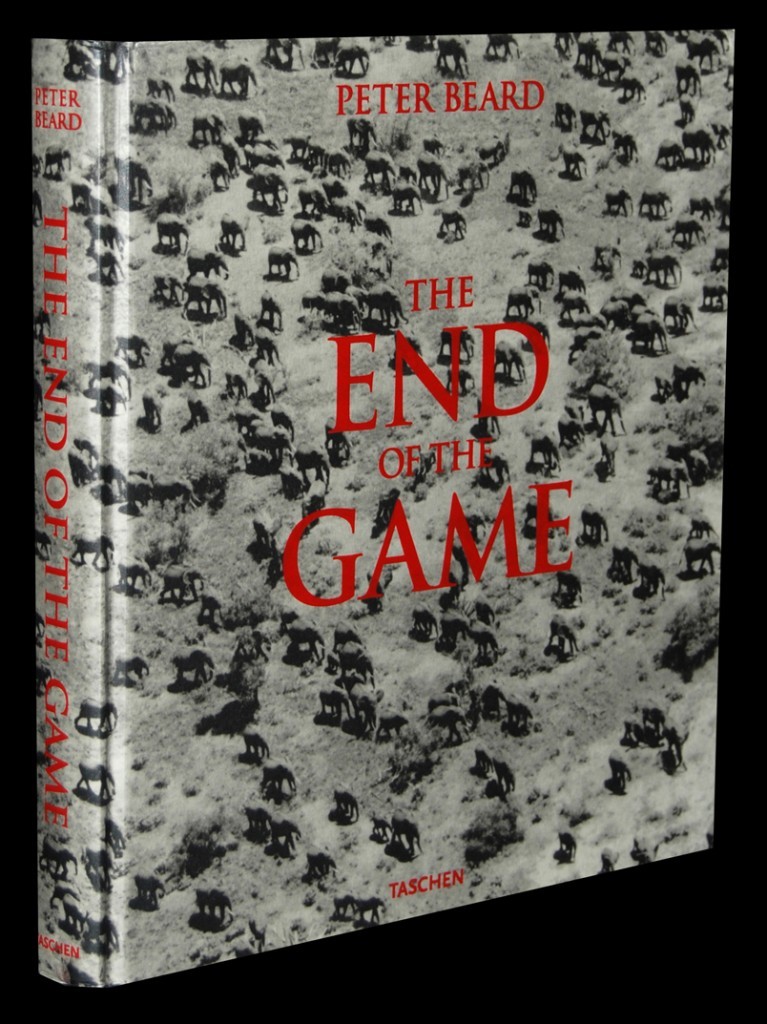 Beard, Peter. The End of the Game. Cologne, Germany and London, UK: Taschen, 2008. ISBN: 978-3-8365-0530-7.
Beard, Peter. The End of the Game. Cologne, Germany and London, UK: Taschen, 2008. ISBN: 978-3-8365-0530-7.
The End of the Game: The Last Word from Paradise
Published 2008
A landmark book on Africa revisited
Focusing on the widespread destruction of the African elephant, Beard tells of the enterprises, explorers, missionaries, and big-game hunters whose quests for progress and adventure were to change the face of Africa forever.
These include Theodore Roosevelt; Ernest Hemingway; Denys Finch-Hatton, the romantic hero of Out of Africa; legendary game warden J.A. Hunter; and railway engineer J.H. Patterson, who became famous as the pursuer of the “Man-Eating Lions of Tsavo.” The End of the Game is a classic work, one that explores the intricate and complex relationship between man and animals and how both struggle to adapt to their changing environments. It is not always a happy story. But it is an important one. The End of the Game is not a book you will soon forget.
It is too late to undo what has been done.
The laws of inevitability which have ruled Africa for millions of years must now be accepted by Africa’s conquerors. To understand this is to begin to realize that we have conquered nothing at all. Man and his ways have intruded with little regard for Africa’s customs and privacy. She has been pursued and despoiled. The End of the Game tells part of this story because it deals with the essence of African life, the animal. And with that very license of humanity by which we have presumed to conquer, we are challenged to reflect upon our defeat.
“The ruined wood we used to know won’t cry for retribution – the men who have destroyed it will accomplish its revenge.” – William Faulkner
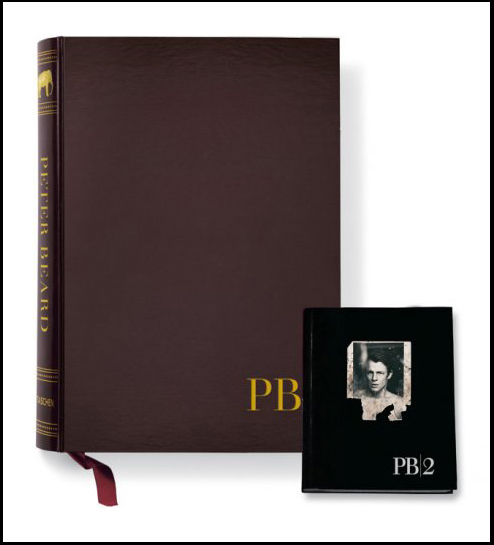 Beard, Peter; Beard, Nejma; Edwards, Owen; Aronson, Steven M.L. Peter Beard, Art Edition. Germany: Taschen, 2006. Sold out.
Beard, Peter; Beard, Nejma; Edwards, Owen; Aronson, Steven M.L. Peter Beard, Art Edition. Germany: Taschen, 2006. Sold out.
Peter Beard, Art Edition: No. 1-250
Limited to 250 individually numbered copies, each signed by Peter Beard
Accompanied by one of two gelatin-silver prints, each in a numbered edition of 125, signed by the artist, and authenticated with a stamp on the back of the photograph from the Peter Beard Studio
Sumptuous leather cover
Packaged in a velvet-lined wood shipping crate
Copies No. 1-125 are accompanied by the signed gelatin-silver print, “Fayel Tall” (1987/2006), edition of 125, 16×20 in.
Copies No. 126-250 are accompanied by the signed gelatin-silver print, “965 Elephants” (1976/2006), edition of 125, 20×16 in.
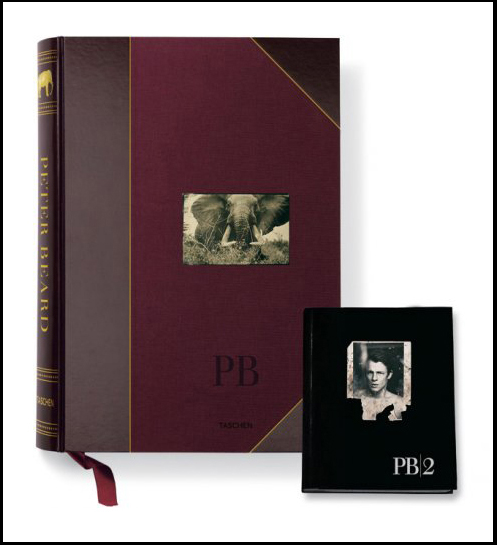 Beard, Peter; Beard, Nejma; Edwards, Owen; Aronson, Steven M.L. Peter Beard, Collector’s Edition. Germany: Taschen, 2006. Sold out.
Beard, Peter; Beard, Nejma; Edwards, Owen; Aronson, Steven M.L. Peter Beard, Collector’s Edition. Germany: Taschen, 2006. Sold out.
Peter Beard, Collector’s Edition: No. 251-2,500
Limited to 2,250 individually numbered copies, each signed by Peter Beard
Spilling out over the pages of this massive tome, Peter Beard’s collages are reproduced as a group for the first time at the size they have always meant to be seen, many of them as foldouts. Hundreds of smaller-scale works and diaries fill the remaining spreads – magnified to show every detail, from Beard’s meticulous handwriting and Old-Master-inspired drawings to stones and bones and bits of animals pasted to the page. Available in both Art and Collector’s editions, this opulent and beautifully crafted limited edition – complete with wooden stand—is a work of art in itself.
Finished in Regina book cloth, with a leather spine and corners
Comes in a clamshell box
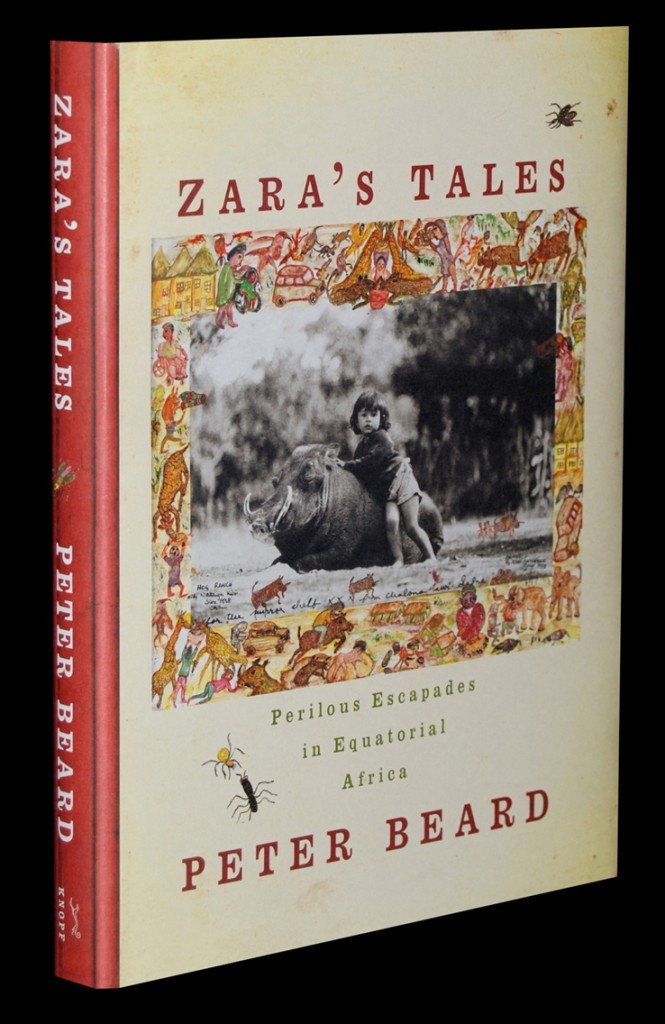 Beard, Peter. Zara’s Tales: Perilous Escapades in Equatorial Africa. New York: Knopf, 2004. ISBN 0-679-42659-0.
Beard, Peter. Zara’s Tales: Perilous Escapades in Equatorial Africa. New York: Knopf, 2004. ISBN 0-679-42659-0.
Zara’s Tales: Perilous Escapades in Equatorial Africa
“Always something new out of Africa.” – PLINY
From adventurer, explorer, photographer, writer, pied piper Peter Beard – eleven irresistible tales, told to his daughter in his tented encampment at Hog Ranch, Kenya, about life, about living, about Africa.
He writes of the East African hills he came to know so well over four decades, where time slows to infinity in a great bottomless, bottle green underwater world…about Nairobi in the 1950s, still a quaint, eccentric pioneer town, full of character of all stripes and tribes, where rhinoceros roamed the streets and local residents went to the movies in pajamas.
He writes of the camp he built twelve miles outside of Nairobi so that he would never be off safari, a forty-acre patch of bush called Hog Ranch (abutting Karen Blixen’s plantation), named for the families of warthogs who wandered into camp, a camp populated with waterbuck, suni, dik-diks, leopard, giraffe, and occasionally lion and buffalo.
In “Big Pig at Hog Ranch,” Beard tells the story of Thaka (translation from the Kikuyu: “handsome stud”), Hog Ranch’s number-one, fearsome, 300-pound warthog, who came into camp and dropped to the ground happy for a vigorous tummy rub, and who one night, “lying in his favorite position, munching on corn and barbeque chicken,” was encroached upon by a bristly haired, wild-looking boar hog. All three-hundred pounds of Thaka exploded straight at the hairy intruder, the two brutish, bony heads crashing together thundering through the camp and Peter witnessed the unleashed power – the bullish strength – of the wild pig…
In “Roping Rhinos,” Beard tells of his first job in Africa, rounding up and relocating rhinos for the Kenya Game Department with his cohort and neighbor, a weather-beaten native of Old Kenya who thrived on danger and refused to bathe – and of the enormous silver-backed rhino bull that became their Moby Dick…
He writes of his quest to photograph overpopulated and habitat-destroying elephants for Life magazine on the eve of Kenya’s independence…of his close encounter with the legendary man-eating lions of “Starvo” (descendants of the famed beasts rumored to be immune to bullets, who in the late nineteenth century halted the construction of the Mombasa railroad, devouring railroad workers and snatching sleeping passengers from their Pullman berths in the dead of night to make a meal of them), who charged the author, “coming in slow motion, like a bullet train erupting out of a tunnel, soundless, like an ancient force.”
He tells of his round-the-clock adventure tracking and studying crocodiles with a game warden-biologist at Lake Rudolf, a tale that begins with one crewmember being grabbed from behind by a ten-foot crocodile and another doing battle with an almost prehistoric monster fish – a 200-pound Great Nile Perch!…and he writes of the final wildlife encounter that ended is safari days, an incident that proved Karen Blixen’s motto: “Be bold, be bold…be not too bold.”
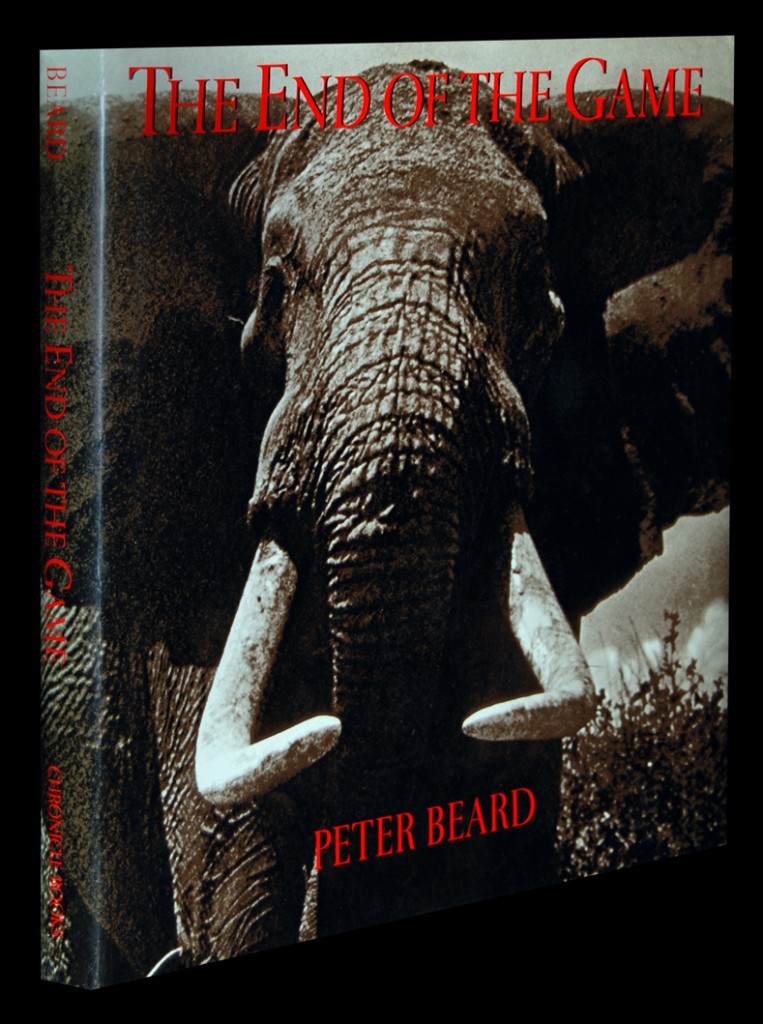 Beard, Peter. The End of the Game. San Francisco: Chronicle Books, 1988. San Francisco: Chronicle Books, 2000. ISBN-10: 0811828816. ISBN-13: 9780811828819.
Beard, Peter. The End of the Game. San Francisco: Chronicle Books, 1988. San Francisco: Chronicle Books, 2000. ISBN-10: 0811828816. ISBN-13: 9780811828819.
The End of the Game: The Last Word from Paradise
In 1961, newly graduated from Yale, Peter Beard settled in Kenya on land adjoining the farm of Karen Blixen (Isak Dinesen). Thus began a special relationship, not only with the woman who was one of the most eloquent chroniclers of life in East Africa, but with the people and animals of the continent. In The End of the Game, Beard documents the history and future of African wildlife. It is a big story, dramatically told, and illustrated with over three hundred contemporary and historical photographs, as well as dozens of paintings by Karen Blixen’s house steward, Kamante Gatura.
Focusing on the widespread destruction of the African elephant, Beard tells of the enterprisers, explorers, missionaries, and big-game hunters whose quests for progress and adventure were to change the face of Africa forever. These include Theodore Roosevelt; Ernest Hemingway; Denys Finch-Hatton, the romantic hero of Out of Africa; legendary game warden J.A Hunter and railway engineer J.H. Patterson, who became famous as the pursuer of the “Man-Eating Lions of Tsavo.”
The End of the Game is a classic work, one that explores the intricate and complex relationship between man and animals and how both struggle to adapt to their changing environments. It is not always a happy story. But it is an important one. The End of the Game is not a book you will soon forget.
Beard, Peter. The End of the Game. Camera Manichi: Japan, 1978.
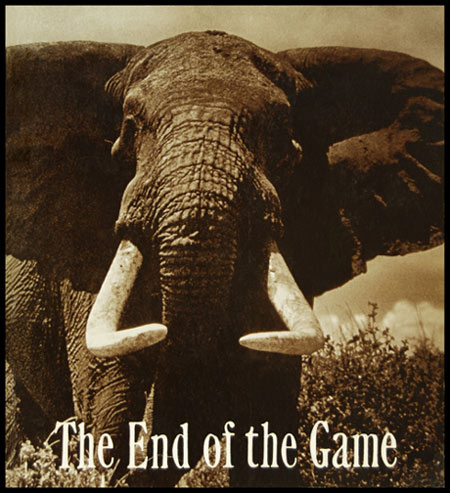 Beard, Peter. The End of the Game. Doubleday, 1977. ISBN-10: 0385131240. ISBN-13: 9780385131247.
Beard, Peter. The End of the Game. Doubleday, 1977. ISBN-10: 0385131240. ISBN-13: 9780385131247.
The Last Word From Paradise
Despite ardent efforts on the part of preservationists the world over, the prognosis for the continued survival of wildlife in Africa remains uncertain, since the animals’ future lies in the hands of those who have caused their plight: human beings. Perhaps the clearest testament of the willful ignorance of man is to be found in the 8,000-square-mile Tsavo wilderness, the largest national park in East Africa, which Johann Krapf was moved to describe in 1849 as “a wood which would have been quite impenetrable by man, had not elephants and rhinoceroses made a way for us…. Their total destruction or removal would be a pity; for they are the true path-makers…” Today Tsavo has been destroyed, and will never be restored.
In 1967, as the woodland cover disappeared, the Ford Foundation undertook a population dynamics study, headed by Dr. Richard Laws, and found that approximately 40,000 elephants were using Tsavo park, where local authorities had counted 8,500 and where the wardens had always estimated 3,000. The recommendation of the research team of a minimum biometric sampling of 2,700 elephants over a five year period was turned down by a bureaucracy that only months before had been plotting to eliminate 5,000 elephants. By opposing the Ford Foundation’s findings, wildlife leaders chose to ignore the crucial fact that populations expand while land does not – a thesis validated by the more than 20,000 elephants that subsequently died inside Tsavo….
The shoreless waste that is now Tsavo – indelibly recorded by Peter Beard in these pages – is the most visible manifestation was have yet seen of the destruction of an eco-system disturbingly similar to our own; in its silence, decay, and limitation the landscape speaks of an intimacy between itself and us, the past and the future, that we will one day soon be forced to acknowledge.
The End of the Game takes us back to the germinal moment of this calamity – the building of the Mombasa Railroad (1896-1901) in the name of “progress,” the inevitable reverse side of which would ensure Africa’s deathbed; for the railroad provided the means through which Africa’s conquerors, would come into her experience and leave their signature.
Excerpted here for the first time are the diaries of J.H. Patterson, a young engineer on the railroad, which record his ten-month pursuit of the man-eating lions that, having consumed twenty eight of his men, reduced the rest of them at first to faint heatedness and then to hysteria all but stopping the railroad in its tracks. It was on the Mombasa line that Halford Mackinder came upcountry in July, 1899. Only a few months later the snow-covered Mount Kenya (home of Ngai, the Kikuyu god), which no one had ever approached, fell to him. Now that foreigners had upcountry access, the big game hunting business, attracting such clients as Hemingway and the King of England, could be invented – and with it, the end of the game.
Beard brings the circle of misery to a close in his chapter “Beside the Carcass of a Beast,” which describes the safari he shared with Teddy Roosevelt’s professional hunter Philip Percival. Embodying as well as echoing the conservation principles of the ex-president, Percival issues prescient warnings about the very Tsavo that he and Bror Blixen had opened up to the safari world more than forty years before.
The End of the Game is a unique collage: a look into the future as well the far past. With its spectacular photographs of a world once splendidly alive, it is indeed the last word from Paradise.
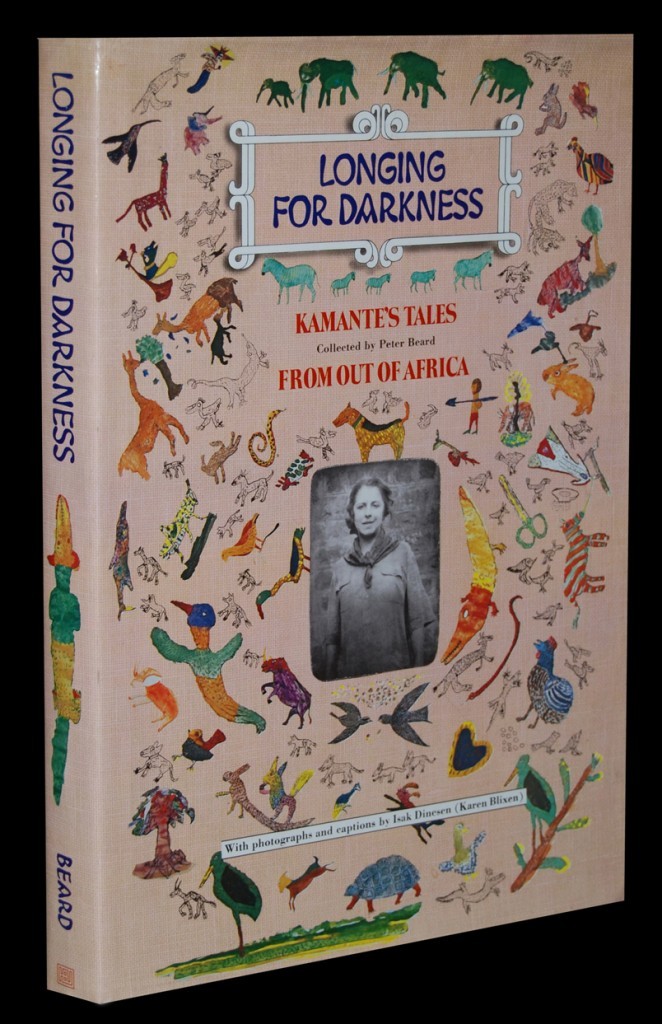 Beard, Peter; and Gatura, Kamante. Longing for Darkness: Kamante’s Tales from Out of Africa. New York: Harcourt Brace Jovanovich, 1975. ISBN: 0-15-153080-7.
Beard, Peter; and Gatura, Kamante. Longing for Darkness: Kamante’s Tales from Out of Africa. New York: Harcourt Brace Jovanovich, 1975. ISBN: 0-15-153080-7.
Longing For Darkness
Jacqueline Onassis says in her beautiful Afterword, “Out of Africa has always meant more to me than any other book. This is the echo to it that Isak Dinesen longed for. Kamante’s drawings and Peter Beard’s photographs share the purity of a wild animal looking at the camera with free and vulnerable eyes…This book is a work of love.”
In one of the most dazzling – and unlikely – books of recent times, the lost world of Isak Dinesen (Baroness Karen Blixen) is stirringly re-created by her old major-domo, Kamante, the hero of her classic Out of Africa. Here Kamante gives his version of Out of Africa (related to Peter Beard and then translated from Swahili and handwritten by Kamante’s son), his inspired rendering of the fables Isak Dinesen taught in Karen Coffee Farm School, and his lyrical watercolors.
Here, too, are many never-before-published photographs from the collections of Isak Dinesen, her brother Thomas, and her great friend Denys Finch-Hatton, along with Peter Beard’s superb photographic record of a world where – for perhaps the last time in history – true wilderness and true sophistication were one (“Very few matters,” Isak Dinesen wrote Peter Beard shortly before her death, “could move me as deeply as your epitaph, or monument, over that Old Africa which was so dear to my heart. In your photographs I seem to receive a greeting from the fauna of the country”).
Kamante Gatura came into Karen Blixen’s life over sixty years ago. In her writings she has described him for all time:
Rarely, rarely, have I met such a wild creature, a human being who was so utterly isolated form the world, and by a sort of firm deadly resignation, completely closed to all surrounding life.
When I stopped and spoke to him, he did not answer, and hardly appeared to see me. In his flat, angular, harassed, and infinitely patient face, the eyes were without glance.
A number of times, many years after our first meeting, he went out of his way to do me a service for which I had not asked him, and when I questioned him why he had done it, he said that if it had not been for me he should have been dead a long time ago.
From that day when he came in to my service and attached his fate to mine, I felt his watchful penetrating eyes on me, and my whole modus vivendi subject to clear unbiased criticism.
He was a thoughtful person. Perhaps the long years of suffering that he had lived through, had developed in him a tendency to reflect upon things, and to draw his own conclusions from everything he saw….There was to me a great perspective in our working together.
As a Chef he was a different thing, and precluded classification. Nature had here taken a leap and cut away from the order of precedence of faculties and talents, the thing now became mystic and inexplicable, as ever where you are dealing with genius…Kamante had all the attributes of genius, even to that doom of genius, – the individual’s powerlessness in the face of his own powers.
It is a moving thing to work together with a demon…in the course of our cooperations, I felt not only the kitchen, but the whole world in which were were cooperating, pass over into Kamante’s hands.
(From Out of Africa by Isak Dinesen © 1937, renewed 1965 by Rungstedlundfonden – by permission of Random House, Inc.)
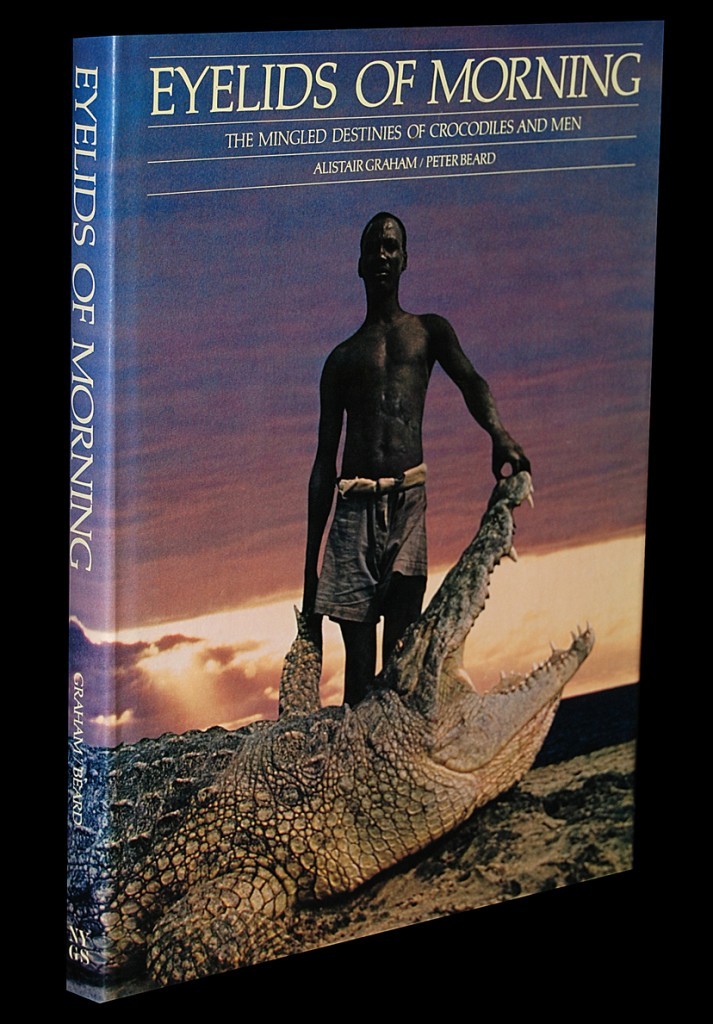 Graham, Alistair, and Beard, Peter. Eyelids of Morning: The Mingled Destinies of Crocodiles and Men. Greenwich, CT: New York Graphic Society, 1973. ISBN: 0-8212-0464-5.
Graham, Alistair, and Beard, Peter. Eyelids of Morning: The Mingled Destinies of Crocodiles and Men. Greenwich, CT: New York Graphic Society, 1973. ISBN: 0-8212-0464-5.
Eyelids of Morning: The Mingled Destinies of Crocodiles and Men
Hailed by reviewers as “enthralling,” “spectacular,” and “vividly dramatic” when it was first published in 1973, Eyelids of Morning remains a standard for natural history reporting, stunning wildlife photography, cutting-edge ecological ideas, and hard-core realism. The legendary and fearsome Nile crocodiles and the Turkana tribespeople who live side by side with them are the focus of this classic, the dramatic and adventurous tale of Alistair Graham’s three years of research on Kenya’s Lake Rudolf. Joined by photographer Peter Beard – whose prodigious talent is displayed here in over two hundred full-color and duotone photographs – Graham undertook an investigation into the habits, history, and dubious future of one of the last great crocodile populations on earth in an unprecedented scientific effort to prevent this population’s almost certain extinction.
A monumental work, Eyelids of Morning will fascinate anyone concerned with the plight of African wildlife – and the future of humanity itself.
The crocodile is a mythic beast, an object of loathing, a creature we stand poised to condemn to obliteration or to decay in national parks – yet we know scarcely anything about it. This book is the story of an extraordinary scientific expedition; it is also a challenge to our conventional and pious ideas about conservation, and a cold look at our own destinies.
Lake Rudolf in Kenya is still one of the wildest regions on earth, and it has the last great crocodile population. Zoologist Alistair Graham spent a year on its shores seeking to learn more about crocodiles before it was too late. Surely no study of population dynamics was ever made in lonelier or more dangerous circumstances – or led to a more absorbing, amusing and beautiful book. Working at first with five Turkana skinners, he was joined shortly by a man peculiarly qualified for the adventure: Peter Beard, a talented and compulsive photographer, and a crack shot. For the data needed could be obtained only from examination of the animals themselves, and in the course of the study 500 crocodiles had to be hunted and shot.
It was a year filled with near-fatal brushes with crocs, bandits, and drowning, with arduous work broken by funny or irritating conflicts with the Turkanas (recorded by Peter Beard’s ubiquitous camera). But author Graham found time to think – about the meaning of his encroachment on the wildness of Rudolf and on the isolation of its native peoples, about “conservation” and violence, about the crocodiles and the Turkanas, both relics of ancient families, both destined to be annihilated by civilization. This story form the wilderness urges a pragmatic approach to conservation and asks disturbing questions about man.
Alistair Graham, a native of Kenya, took a master’s degree in Zoology at the University of East Africa and has worked with wildlife ever since. A pragmatist who sees wildlife as a natural resource as well as a spiritual utility, he left a post with the Kenya Game Department to form Wildlife Services Limited, a private company offering research and management services to conservation agencies. He is author of numerous scientific publications on Africa wildlife, and of The Gardeners of Eden, an exploration of the origins, historical and psychological, of man’s relationships with wild animals.
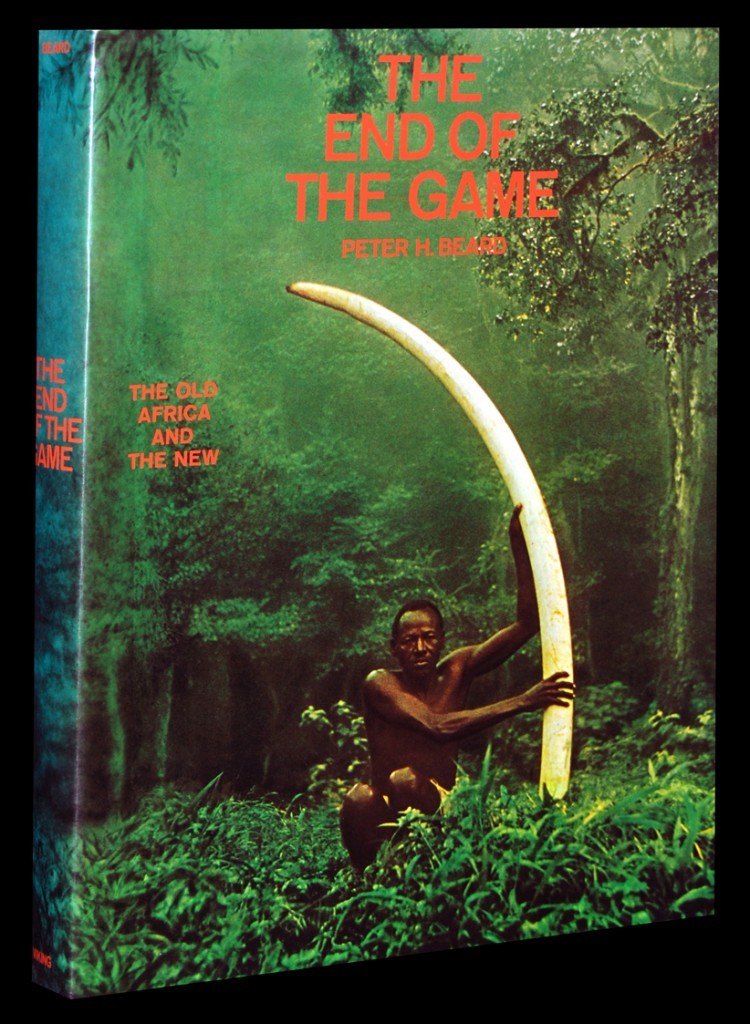
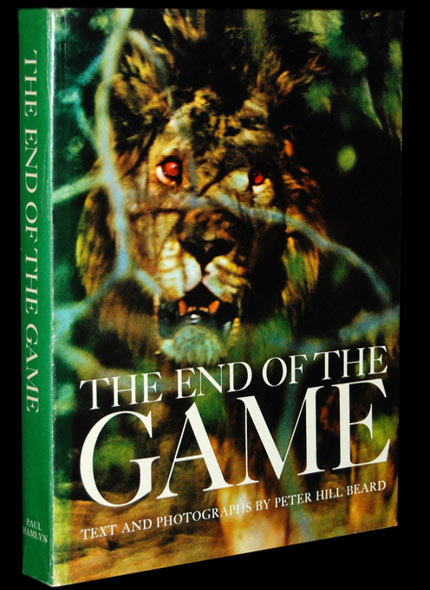
Beard, Peter. The End of the Game. Viking Press, New York, 1965.
The End of the Game: The Last Word from Paradise
Before Isak Dinesen died in 1962 she saw many photographs and two chapter of this extraordinary book, and she wrote these words:
“Very few matters could move me as deeply as this epitaph, or monument, to the Old Africa which was so dear to my heart – the continent of wisdom, dignity, and deep poetry, equally expressed in nature, beast, and man.”
The Old Africa, as reflected in Dinesen’s memorable writings, drew Peter Hill Beard to Kenya for the first time when he was seventeen. Since then, he has taken his camera and notebooks on three other extended trips to the region and has spent the major part of these nine years studying and recording the profound transformation from Old to New Africa. This change, one that has affected every phase of social and economic existence, is documented in the author’s photographs, which are some of the most magnificent pictures ever made of the very essence of African life – the animal.
The End of the Game blends past and present – a span of historical events and the author’s own experience within only two generations – to make stunningly clear how swiftly Old Africa has disappeared. It tells of Mackinder’s feat of climbing Mt. Kenya in 1899, and of the railroad’s coming from the coast to what is now Nairobi: these were heroic accomplishments of white men, who then brought their technology, medicine, and government into East Africa. The tragic accompaniment, undreamed of by Europeans and Africans alike, has been the relentless distortion of the balance of nature that had supported the land, people, and animals for centuries. To understand how this happened in little more than sixty years is to understand the confusion in Africa today.
Then the photographs and text deal with Beard’s camera safaris throughout the Shag and Greater Shag, as the near and far reaches of Kenya are called. Beard visited remote ranches and native villages, knew game wardens and former poachers and himself participated in the work of modern game control. Contrasting scenes from earlier days are here too, in the reminiscent talks he was privileged to have with some of the great white hunters whose entire lifetimes have been spent in Africa: Philip Percival, the dean of them all, who was Teddy Roosevelt’s and Ernest Hemingway’s hunter; and even E. S. Grogan, who accomplished the incredible walk from Cape to Cairo in 1900. J. A. Hunter, who pioneered new safari country with Isak Dinesen and was one of Africa’s most experienced experts on African wildlife, saw Beard’s manuscript and pictures and said of it before his death in 1963:
“To quote your Introduction, a book about Africa is necessarily a book about many things, and this one is precisely that: a memory of the past, a record of the present, and an image of the future. It was to show the pathos and savagery of the death of an Africa that this book was in part intended. It is to our shame and to its credit that is succeeds in this end.”
But for the future there is still hope. The book concludes with a lively account of the last banquet of the White Hunter’s Association, wherein it is clear that the modern political state of which Kenya is a part at last knows vast importance of the animal in Africa.
Above and beyond assembling so much intimate knowledge of Africa, the text is the fascinating background for Beard’s magnificent photographs. These far surpass any other collection ever recorded in Africa by one man’s camera. Other decorations include old engravings, native drawings, and Beard’s own woodcuts.
Beard, Peter. The End of the Game. Paul Hamlyn. London, United Kingdom, 1965.
This book is a chronicle in words and pictures of the gradual remorseless destruction of the central symbol of Africa’s life – the animal. It is also the story of the white hunter who once killed only to live but who has now become a hired hand for the entertainment of rich sportsmen. Fifty years ago men had to be protected from beasts; today the beast must somehow be protected from men.
The first section of the book recalls that past ere when the coming of white men was not yet an intrusion but the very best kind of pioneering adventure – free, undirected and spontaneous. The extreme contrast of the situation in Africa today is sharply pointed by the comments and experiences of some of Africa’s greatest white hunters and game wardens, men with a lifetime’s experience of Africa. In their company, and armed with a 35-mm. camera and a .375-calibre rifle, Peter Beard explored Kenya to capture a permanent record of the magnificent animals – before it is too late. In a series of unique photographs the elephants, giraffes, hippopotami, cheetahs, water buck, zebras and lions of Africa are shown living in a state of natural grace and dying with majestic courage.
Peter Beard was first attracted to Africa in 1955 by reading Isak Dinesen’s book Out of Africa. She helped him to establish the direction of his own book and before her death in the summer of 1962 she wrote: “Very few matters could move me as deeply as this epitaph, or monument, to the Old Africa which was so dear to my heart – the continent of wisdom, dignity, and deep poetry, equally expressed in nature, beast, and man.”
Beard, Peter. Das Ende Der Grossen Jagd, du-Atlantis (Germany), March 1965.